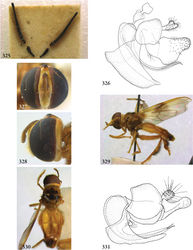Rhoga
| Notice: | This page is derived from the original publication listed below, whose author(s) should always be credited. Further contributors may edit and improve the content of this page and, consequently, need to be credited as well (see page history). Any assessment of factual correctness requires a careful review of the original article as well as of subsequent contributions.
If you are uncertain whether your planned contribution is correct or not, we suggest that you use the associated discussion page instead of editing the page directly. This page should be cited as follows (rationale):
Citation formats to copy and paste
BibTeX: @article{Reemer2013ZooKeys288, RIS/ Endnote: TY - JOUR Wikipedia/ Citizendium: <ref name="Reemer2013ZooKeys288">{{Citation See also the citation download page at the journal. |
Ordo: Diptera
Familia: Syrphidae
Name
Rhoga Walker – Wikispecies link – Pensoft Profile
- Rhoga Walker, 1857: 157. Type species: Rhoga lutescens Walker, 1857: 157, by monotypy.
- Papiliomyia Hull, 1937a: 27. Type species: Papiliomyia sepulchrasilva Hull, 1937: 28, by original designation. For synonymy see Hull (1949)[1].
Description
Body length: 5–10 mm. Stingless bee mimicking flies with short to moderately long antennae and oval, kite-shaped or more or less parallel-sided abdomen. Head slightly wider than thorax. Face convex; narrower than an eye. Lateral oral margins not produced. Vertex narrow, convexly produced and shining in most species, flat in some. Occiput wide and parallel-sided over entire length. Eye with short, sparse pile. Eye margins in male not converging at level of frons, with mutual distance 2 to 3 times as large as width of antennal fossa. Antennal fossa about as wide as high. Antenna as long as or shorter than distance between antennal fossa and anterior oral margin; basoflagellomere shorter to longer than scape, oval; bare. Postpronotum pilose. Scutellum semicircular, in some species weakly sulcate apicomedially; without calcars. Anepisternum without sulcus; pilose anterodorsally and posteriorly, widely bare in between. Anepimeron entirely pilose. Katepimeron convex; bare. Metapleurae either separated or forming postmetacoxal bridge. Wing: vein R4+5 without posterior appendix; vein M1 perpendicular to vein R4+5; postero-apical corner of cell r4+5 rectangular, with small appendix; crossvein r-m located within 1/4 of cell dm, usually within basal 1/10. Abdomen oval or kite-shaped, 1.5 to 2.5 times as long as wide. Tergites 3 and 4 fused. Sternite 1 pilose or bare. Male genitalia: phallus furcate near apex, with dorsal and ventral process equally long; epandrium without ventrolateral ridge.
Diagnosis
Vein R4+5 without posterior appendix. Occiput widened and parallel-sided over entire length.
Discussion
In some species (e.g. Rhoga mellea (Curran, 1940), Rhoga maculata (Shannon, 1927)) the metapleura are separated and do not form a postmetacoxal bridge. So far in Microdontinae, this character state was known only in the genus Spheginobaccha (Cheng and Thompson 2008[2]).
The type specimen of the type species, Rhoga lutescens Walker, 1857, is not present in the BMNH-collection (pers. comm. N. Wyatt), where it is supposed to be according to Thompson et al. (1976)[3] and Thompson (2010)[4]. Apparently it is lost.
Diversity and distribution
Described species: 5. Central and South America. Several undescribed species are known to the first author.
Taxon Treatment
- Reemer, M; Ståhls, G; 2013: Generic revision and species classification of the Microdontinae (Diptera, Syrphidae) ZooKeys, 288: 1-213. doi
Other References
- ↑ Hull F (1949) The morphology and inter-relationships of the genera of syrphid flies, recent and fossil. Transactions of the Zoological Society 26: 257-408. doi: 10.1111/j.1096-3642.1949.tb00224.x
- ↑ Cheng X, Thompson F (2008) A generic conspectus of the Microdontinae (Diptera: Syrphidae) with the description of two new genera from Africa and China. Zootaxa 1879: 21-48.
- ↑ Thompson F, Vockeroth J, Sedman Y (1976) Family Syrphidae. A catalogue of the Diptera of the Americas south of the United States 46: 1-195.
- ↑ Thompson F (2010) Syrphidae. Systema Dipterorum, Version 1.0. http://www.diptera.org/ [last visit: March 2011]
Images
|
